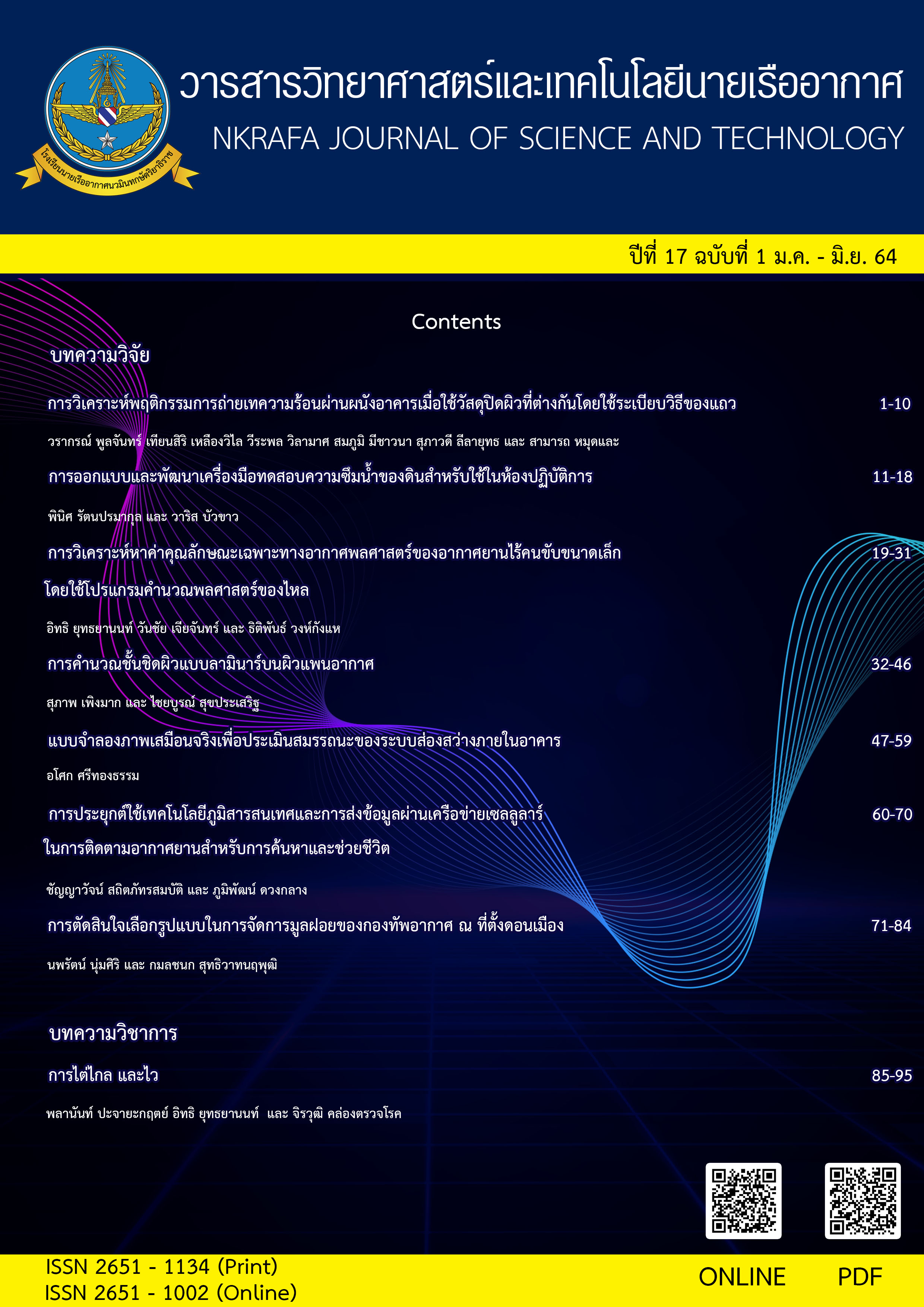Geo-Informatics and Communications via Cellular Networks in Aircraft Tracking for Search and Rescue: An Application
Main Article Content
Abstract
Obscuring terrain is indeed disadvantageous to low-altitude aircraft detection with radars, because of which the exact position of aircraft in case of lost contact at low altitude or accidents cannot be determined. Search and rescue teams must therefore unnecessarily operate in wide areas. Too much time is then unavoidably spent, which could lead to unexpected casualties occasionally. Thus, while being deployed in mission areas, military aircraft should be tracked continuously.
For this reason, we propose an application of Geo-Informatics for tracking RTAF’s aircraft. As the result, while flying at lower than 2,500 ft altitude above ground, geographic information can be relayed from the GPS tracker and stored from the start to the end of each sortie. In addition, positions and route history can always be displayed in Geographic Information System (GIS). RTAF’s Command and Control System hence could be more competent at not only tracking RTAF’s aircraft but also detection for search and rescue missions, which would lead to situation awareness of all personnel in War Room and help make decisions and handle situations in time.
Article Details

This work is licensed under a Creative Commons Attribution-NonCommercial-NoDerivatives 4.0 International License.
- Content and information in articles published in NKRAFA Journal of Science and Technology are comment and responsibility of authors of articles directly. Journal editorial do no need to agree or share any responsibility.
- NKRAFA Journal of Science and Technology Articles holds the copyright of the content, pictures, images etc. which published in it. If any person or agency require to reuse all or some part of articles, the permission must be obtained from the NKRAFA Journal of Science and Technology.
References
[2] อัญญา บูชายันต์, วนมพร พาหะนิชย์, ภูมิ สาทสินธุ์. (2018). เทคโนโลยีภูมิสารสนเทศกับการรู้เรื่องภูมิศาสตร์. Special Issue: JHSSRRU, 20: 385-397.
[3] nPerf. (2021). แผนที่ความครอบคลุม 3G/ 4G/ 5G, Thailand. แหล่งข้อมูล: https://cdn.nperf.com/th/map/TH/-/.
ค้นเมื่อวันที่ 15 กุมภาพันธ์ 2564.
[4] ปรีชา พินชุนศรี, ฐิติรัตน์ จันทรดารา, ยุทธเดช ช้อยแสง, ธนิกา กอสินประเสริฐ, ดวงนภา บัวสันต์. (2562). การพัฒนาโปรแกรมสารสนเทศเพื่อการบริหารจัดการด้านทะเบียนทรัพย์สินของมหาวิทยาลัยเอกชนแห่งหนึ่งในจังหวัดนครปฐม.วารสารมหาวิทยาลัยคริสเตียน, 25(2): 79-91.
[5] ลัญฉกร วุฒิสิทธิกุลกิจ. (2542). หลักการะบบโทรศัพท์เคลื่อนที่ กรุงเทพฯ : จุฬาลงกรณ์มหาวิทยาลัย.
[6] สกรณ์ บุษบง, ทิพวัลย์ แสนคํา, นพพัสสร พูนสังข์, มนัสวี เดชบันดิษ. (2563). การพัฒนาระบบจัดการคลังเลือดออนไลน์พร้อมชุดอุปกรณ์แจ้งเตือนอุณหภูมิตู้เก็บเลือดโดยใช้เทคโนโลยีอินเทอร์เน็ตสรรพสิ่งกรณีศึกษาโรงพยาบาลพุทไธสง อําเภอพุทไธสง จังหวัดบุรีรัมย์.วารสารมหาวิทยาลัยคริสเตียน, 7(1) : 40-50.
[7] นิรุทธ์ รวยรื่น, เกรียงไกร ปอแก้ว. (2014). การใช้แมพรีดิวซ์เชื่อมคอลเลคชันของฐานข้อมูลโนเอสคิวแอลบนมองโกดีบี (Using MapReduce to Join Collection of NOSQL Database Based on MongoDB).วารสารวิจัย มข.(ฉบับบัณฑิตศึกษา), 14(2): 23-34.


